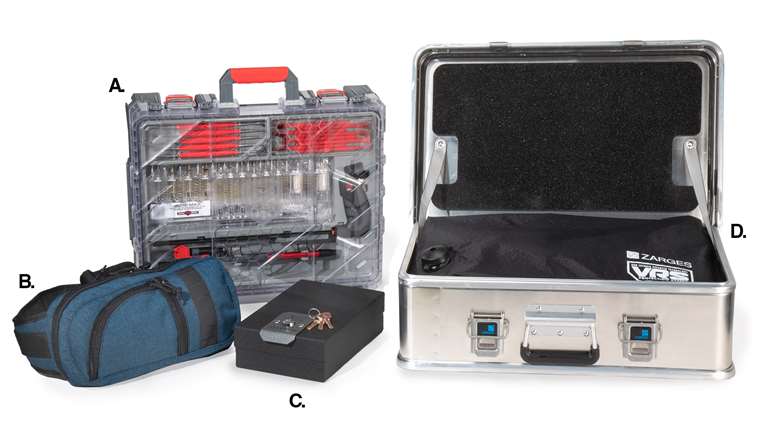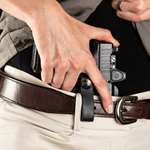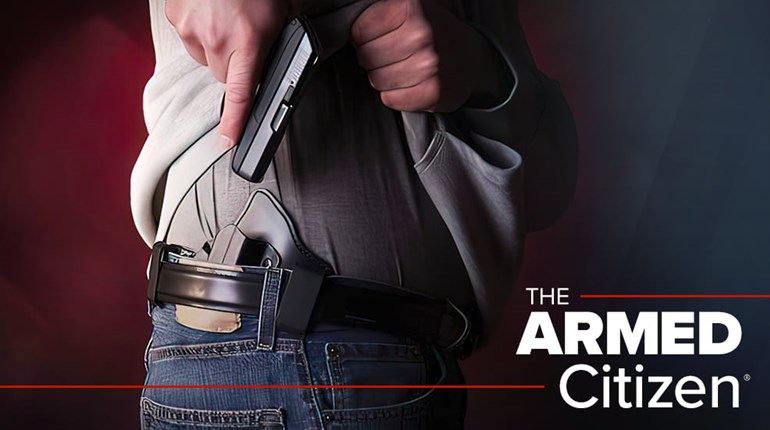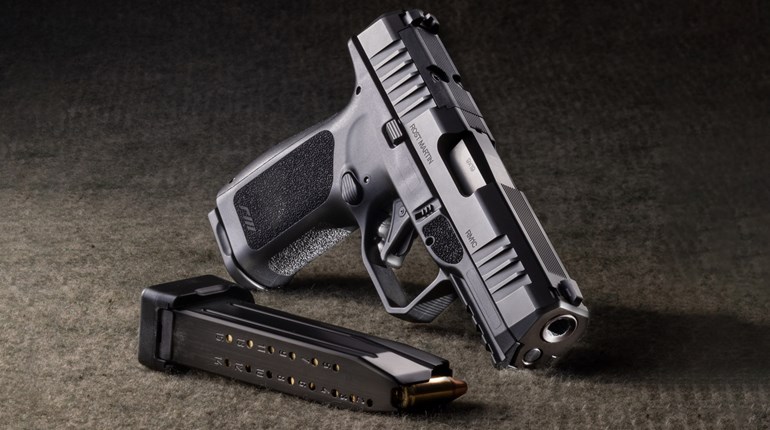Olympian Nick Fairall was representing the Unites States in 2015 at a snow ski-jumping World Cup competition in Austria. He launched off the ramp and soared a distance of about 410 feet from a height of about 13 stories. The jump looked and felt great. As he landed, though, he felt his skis stick against the snow—and then he was tumbling.
The awful accident broke his L1 vertebrae. An operation stabilized it, but his spinal cord had been severed; as a result, he lost the use of his legs.
But Fairall was used to facing challenges, so even such a serious accident couldn’t keep him down for long. He took up adaptive water skiing only six months later. He is seriously passionate about sports, and he had always loved shooting, so it was only a matter of time before he took up adaptive shooting as well. In 2020, for example, he won the Adaptive Defensive Shooting Summit, hosted at SIG Sauer. This was his first time competing in this sport.
A1F: How did you first learn to shoot?
Fairall: My father, who grew up on a farm in England, taught me using an old Remington .22 when I was six or eight years old. The rifle was a little too heavy for me to handle at first, but I still loved it. I treasure those memories going into the field and target shooting with my father.
A1F: Did you ever shoot competitively growing up?
Fairall: No, my family shot on our property in central New Hampshire. I just became more and more interested as I grew older, but I always did it recreationally.
A1F: You broke your L1 vertebrae competing in ski jumping in 2015 and lost movement in your legs. Please tell us about that time and how you found your way through it.
Fairall: In the 2014 Olympics, I represented the U.S. for ski jumping. The following year, I was competing in the World Cup in Austria. I had a great jump and landed, but the snow was stickier than usual, so my skis stuck for just a minute. The momentum basically power-drove me into the ground. I felt an extremely sharp pain in the bottom of my back, and, in all that pain, I had this very weird thought about how my boots were too tight—that I had tightened them too much. So I asked the medical personnel if they could remove my ski boots. One of them told me, “Your boots are already off.” That was the moment I realized this was a very serious injury and a very different crash than ones I had experienced in the past.
I was rushed into emergency surgery. It was a very uncertain time. I didn’t know what to think or what to make of it. My father and two sisters flew over to see me in the hospital, and I started the long road back to recovery with them. I went back into my usual competitor mindset; this was a challenge set before me and something I needed to overcome. I wasn’t sure what was ahead, but I knew I would find a way to overcome it. But, just a short while after my surgery—whether days or weeks, I’m not sure—one of my doctors came in and said, “You’ll never walk again.” So, then I had to shift my recovery goals from “Alright, I need to get back to sport” to “Alright, I’m going to find a way to live my life as best I can.”
One of the things that I was very uncertain of was that I didn’t know what to expect for life at all. I didn’t know anything about adaptive lifestyles or being in a wheelchair. One of my best friends I had throughout my recovery—and now—was Jess Tidswell, the physical therapist for our team. She’s been involved in adaptive sports much of her career, and she kept telling me about all these other sports I could do and what was possible. She told me, “You can still do anything you want; you might just have to do it a little bit differently.” So, it’s not if I can do something but how I can. And luckily, the adaptive community and adaptive sports have grown so much that it’s very available for anyone looking to do it.
I was in rehab from January to July, trying to get back. In the hospital, I heard about the High Fives Foundation. They had a water ski camp coming up in July, when I was being discharged from the hospital. I wanted to do this, despite my doctors suggesting I not do anything for a year after. So, just six months after my injury, I was out doing adaptive water skiing. We made it happen. I found it extremely amazing.
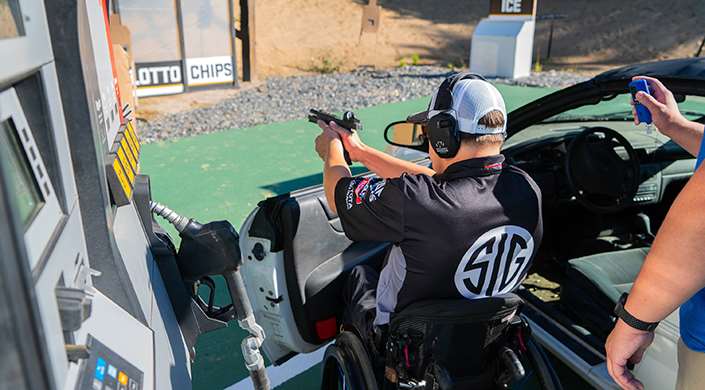
A1F: So, you did get back to sports right away. What about adaptive shooting—when did you start that?
Fairall: I didn’t do that right after.
I can’t remember exactly when I went back out to my backyard to shoot, but I did, and I started looking forward to it. So, then I went and took a few classes—defensive pistol and rifle—at SIG Sauer. I reached out to them and told them I was in a wheelchair and asked about taking the classes. They helped me figure out better ways to handle a firearm from the wheelchair. But it wasn’t until 2020 that I shot competitively, at the Adaptive Defensive Shooting Summit.
A1F: You won that competition, and it’s clear competing must be in your DNA. But was there anything that surprised you about adaptive shooting?
Fairall: What took me by surprise really was how welcoming the community was, how willing they were to give advice and help me approach certain situations. I thought it was phenomenal. I got to train with SIG instructors and they were very open, very willing to help. I felt like it was OK to try something new. I wasn’t as nervous as I thought I would be going into the competition, and the competitors were welcoming, too. The shooting community gets a bad rap in the mainstream media, but I felt like what I had heard about all of that was wrong. They were all there to help me.
A1F: Do you reach out to other people who are interested in trying the shooting sports or buying their first gun for sport or self-defense?
Fairall: I’ve definitely started trying to do that. Our sport is at a pivot point. Where does the tide go—do we start getting smaller or do we grow as a community? So, I’ve tried to reach out to friends and family and to people I don’t know. I start with regular conversation. I offer to take them to the range. I want to make sure they have a fun and positive experience. I start them out small if they’re hesitant and keep it a positive, fun experience for them. We’re really not trying to be precise right away. I use steel or responsive targets so they get that visceral feedback. Safety is the top priority, and otherwise it’s about making them comfortable. But it really just starts out as a conversation.
A1F: How has adaptive shooting competition helped to change or develop you?
Fairall: Because of my injury, I lost a sport I absolutely loved—ski jumping. But adaptive shooting has given me the opportunity to get back into another sport that I love to do and have a huge passion for. Getting out and being active strongly correlates to the emotions you feel. I tell people the root word of “emotions” is “motion.” The amount of motion you have is going to correlate to what you feel. And especially for people with disabilities, this is so important. It’s very empowering and uplifting and positive. It’s been wonderful to have that feeling again of going out and doing something I love to do. I’m grateful these opportunities exist.
A1F: Do you think it’s particularly important for disabled people to be able to exercise their Second Amendment rights?
Fairall: Absolutely! I wholeheartedly believe the Second Amendment is for everyone. You have the right for self-preservation and the right to defend those around you. Being in a wheelchair or having a disability does not disqualify you from those rights. Shooting is a great thing to do. There’s a way to set it up for anyone. I even saw a quadriplegic shooting from a wheelchair, activating the trigger with his breath. Anyone and everyone can do it.
And, people with disabilities and wheelchair users are vulnerable classes. Criminals and people looking to do evil in the world search for easy targets, and people with disabilities seem like easier targets. So they have more reason to find ways to defend themselves. Most criminals are smart enough to not get involved with someone who has an equalizing tool.
There’s also the emotional aspect. Injuries and disabilities can be a roller coaster for sure. There are definitely the ups and downs, and it’s definitely hard, but there are ways to overcome those downs and magnify those ups. I’ve known a lot of people with these kinds of life-altering injuries and people born with disabilities, and I’ve seen so many of them rise up out of their dark times. My injury is pretty visible, and people might feel bad about it. But my emotions are the same as before the injury, just for different reasons. Everyone goes through things, like cancer or losing a loved one. That’s where I’ve found movement and being active has allowed for much greater ups and minimized those downs.
A1F: Do you think further restrictions on the right to bear arms might disproportionately affect disabled people?
Fairall: Oh, yeah. That new ruling from the ATF on pistol braces, for example; these braces were designed for people with disabilities, though anyone can use them. Getting rid of pistol braces greatly affects the disabled. And it ups the cost. Let’s say you have to pay $200 additional every time to exercise your rights, for registering something like a pistol brace, so people with disabilities now have to pay $200 to use something that helps them shoot safely and effectively. It’s a form of discrimination.
There are already a ton of unconstitutional restrictions on our rights. I think there are something like 20,000 gun-control laws on the books when you consider federal, state and local. If we had that many restrictions on our right to free speech or other natural rights, people would be in an uproar! With that many already, no additional laws are going to help deter crime. Criminals notice vulnerable targets. Disabled people are already vulnerable. Putting more restrictions just puts us at a greater risk.
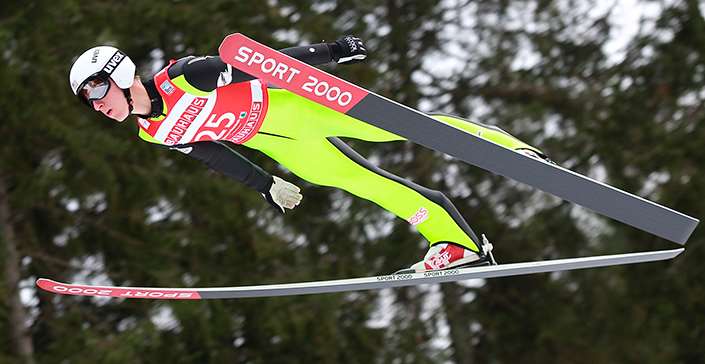
A1F: How can we do a better job of reaching more people and helping them, whatever their backgrounds or physical limitations, to pick up this freedom?
Fairall: Our responsibility as firearms owners and people in the shooting and Second Amendment community is to reach out and talk to people. Have one-on-one conversations. Invite them to the range. Listen to them and their concerns. Don’t shun them because they have misconceptions. Educate them and don’t make them feel dumb. It’s our job to win them over. We want to show them it’s a safe, enjoyable thing to be part of. It all starts with those one-on-one conversations. There are so many ways to go about shooting. There are so many options out there.
I think we should be posting stuff on social media, too—show pictures from range days, something like that. Show people having fun. Get people accustomed to seeing firearms in a positive way. It helps people become more familiar and to realize it’s mainstream.
A1F: What do you see going forward for you?
Fairall: I’ve been working with SIG for the past year, and they’ve been a great company to partner with. I’ve been blessed to have them supporting me. I plan to compete more here locally and hope to expand throughout the country. I will also take more people to the range and show them how great the firearms community can be. And I want to get my teaching certificate and to teach people officially rather than just at the range at my house!
A1F: How can people follow you or hear more from you?
Fairall: They can find me on Instagram @Nick_Fairall and then on Facebook. I’ll have a website up and running eventually, too.



